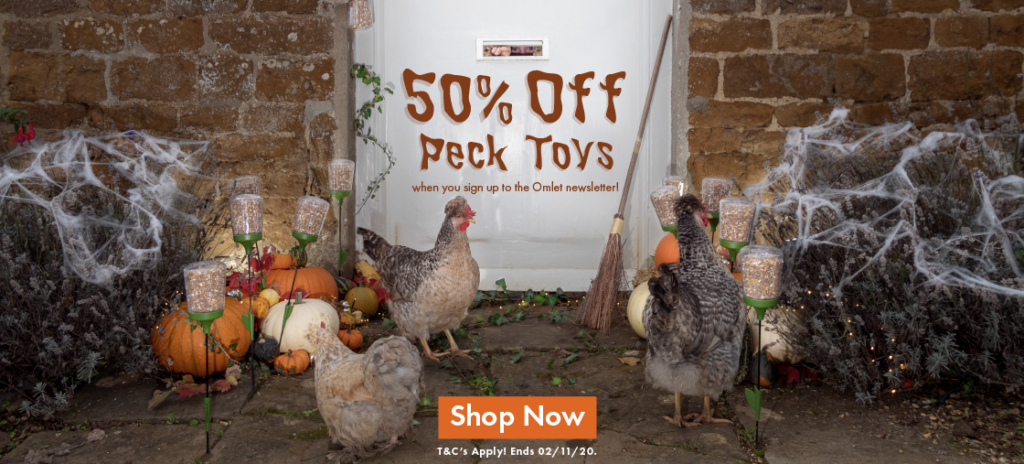
Trick or treat your hens this Halloween with a s-peck-tacularly spooky Peck Toy! Save 50% on Peck Toys when you sign up to the Omlet newsletter!
Terms and conditions
This promotion is only valid from 29/10/20 – midnight on 02/11/20. Once you have entered your email address on the website you will receive a discount code that can be used at checkout. By entering your email you agree to receive the Omlet Newsletter. You can unsubscribe at any point. This offer is available on single Poppy and Pendant Chicken Peck Toys only. The offer does not apply to Twin Packs or Twin Pack with Caddi Treat Holder. Offer is limited to 2 Peck Toys per household. Subject to availability. Omlet ltd. reserves the right to withdraw the offer at any point. Offer cannot be used on delivery, existing discounts or in conjunction with any other offer.
This entry was posted in Chickens on October 29th, 2020 by linnearask

Chickens really are wonderful pets for the whole family. Aside from providing delicious daily eggs, they’re super fun to watch, hang out with, and can teach children valuable life lessons. Compared to other pets, chickens are also relatively low maintenance, and caring for them doesn’t really require much that children from primary school age won’t be able to at least take part in. Read on to find out more reasons why chickens are great pets for families with children.
Responsibility
Having chickens will help children of all ages learn about taking responsibility for another living being. Whilst they should never be given full responsibility for all the chook care duties, even allowing them to scatter some corn for their feathered friends or refilling the drinker can help children build a wondrous connection and gain a better understanding of what it means to take care of another.
Routines
Chickens are pets of routine and part of your daily regime as a keeper includes, but is not limited to, cleaning out the coop and run, filling their feed and waterers and collecting eggs. Having pets that need structure helps children to understand the importance of a routine, which, is something many kids can thrive with,
Food
Keeping chickens will teach your children that food does not magically appear on supermarket shelves. If they care for their own chickens, they’ll hopefully realize how important it is for animals to have enough space and adequate care, and they will not take animal products for granted.
Chickens and children: things to consider
Dream big, start small
Whilst you might be tempted to start off with more, begin with a smaller flock of no more than 5 chickens. That way, your children will easily be able to differentiate them and give them names based on their personalities. Too many at once makes the chickens seem like a flock rather than a group of individuals. And at a later date, there’s nothing stopping you from falling victim to the infamous “chicken math” when your children are older!
Happy hens
Stick to hens. It’s probably a good idea not to get a rooster to start with. Whilst some chicken keepers have their own personal reasons as to why they want to keep cockerels, they’re not for everyone. For one, they’re much more confident and pushy than hens and can be a bit intimidating for younger children.
Easy peasy coop cleaning
Get a coop that makes chicken keeping easy, so that the kids can help. The Eglu Cube chicken coop is perfect for adults and children alike. With the innovative design, even younger members of the family can even help with the cleaning of the coop. Simply empty the dropping tray and wipe down the smooth surfaces of the house once a week, and your coop will look shiny and new every time.
It’s super easy to let the chickens out in the morning and close the coop at night too with the optional Autodoor. Plus, collecting fresh eggs is a breeze with the egg port found on the side of the coop.
Start them young
Even if you’re not incubating eggs and rearing chicks yourself, getting young chickens is a good idea if you want your children to be involved. Encourage regular interaction, and try to pick up the chickens regularly to get them used to being handled. This is sometimes made easier by having the chickens in a run that is easy to access, like the Walk In Run.
Which breed?
There are a number of chicken breeds to choose from, all of which with their own pros. When choosing chickens as family pets though, opt for a friendly and hardy breed that’s renowned for getting on well with kids. Silkies, for example, are famous for being loving and happy to be held, Orpingtons are calm and affectionate and Cochins easily adapt to any situation they are confronted with.
Omlet and your family pet
Whether you’re a first-time chicken keeper looking for a new family pet or expert, Omlet has everything you need to give your chooks the best lives possible. From our range of easy-to-clean chicken coops, to our Autodoor to take the guesswork out of bantam bedtime, chicken keeping has never been more simple or fun than with Omlet.

This entry was posted in Chickens on October 23rd, 2020 by linnearask
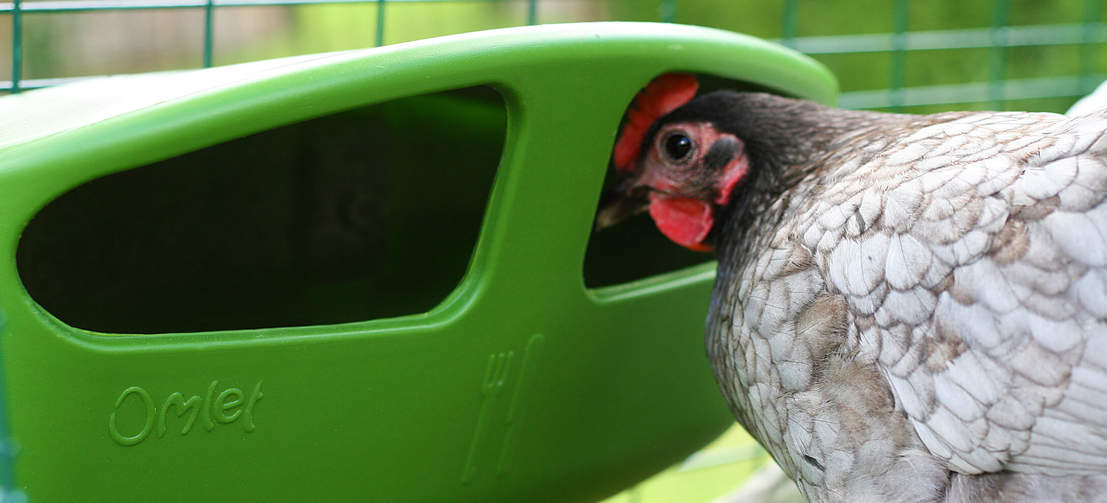
Chickens are great foragers, and free-range birds will peck and scratch for all kinds of wild treats, from grass and weeds to worms and beetles. However, even a hen with all-day access to a backyard or meadow still needs to be fed with high-quality layers pellets. These contain the correct balance of protein, carbohydrate, vitamins and minerals (notably calcium for egg shells) that will keep them happy and healthy. Protein is particularly important for healthy egg production.
A general ballpark figure is very useful, to guarantee that the hens’ dietary requirements are being met. For medium-sized breeds you need to feed between 115 and 120 grams (just over a quarter of a pound) of feed per chicken per day, which is 805 to 840 grams (one and a half pounds) of feed per chicken per week. A slightly larger Sussex will eat a bit more, and the smaller Leghorn will eat slightly less, while a small bantam breed will only eat between a half and three quarters of that amount.
Chicks, Pullets and Layers
Until it is five weeks old, a chick will need to have its diet supplemented with protein-rich ‘chick crumbs’. Between then and 18 weeks old, while they are ‘pullets’, the birds will need ‘growers pellets’ to put on weight. As soon as the hens begin laying, they only need the regular ‘layers pellets’. These, again, are rich in protein, calcium and all the other essential nutrients.
The hens will also need daily access to grit. Treats are fine, as long as they are not being offered so frequently that the hens fail to eat their share of pellets. Corn is a healthy treat, and birds that have free-range access to grass will be in chicken heaven.
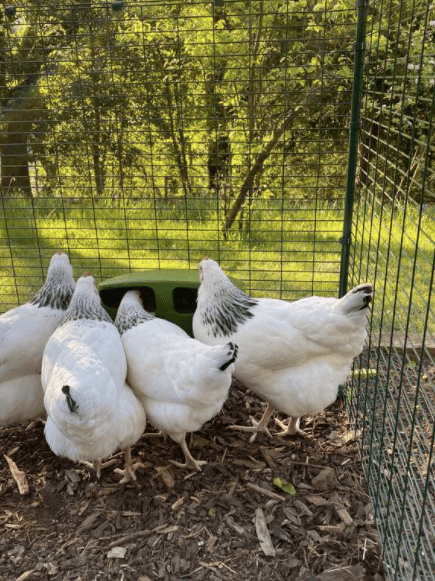 How Can You Make Sure Each Hen is Getting Her Share of the Food?
How Can You Make Sure Each Hen is Getting Her Share of the Food?
Any flock of chickens develops a natural pecking order, and the dominant birds will tend to eat their fill before the others, if there is not enough space for all the hens to fill their crops at once (something they like doing shortly before retiring for the night). A solution here is to buy a wide-bottomed feeder that allows several birds to eat at once, or to use more than one feeder. This will ensure the timid hens get their fair share of food.
However, as long as you have provided enough for all your hens, there should always be food left in the feeder when the dominant birds have had their fill. You should still keep a close eye on the health of your flock, though. Issues such as soft shells or feather-plucking can be signs of dietary deficiencies, and the problem might lie in the quality rather than the quantity of the birds’ diet.
Do Hens Eat the Same Food All Year Round?
Chickens moult every year, and will usually eat more food during this process, to ensure their bodies have all the protein they need to grow a new set of feathers. Hens usually eat more during cold weather, too, in order to fuel their metabolisms and stay warm. Free-range hens also tend not to find as many treats in the backyard during the winter, as the insect population is at low ebb and the grass is no longer growing.
You can add a little more food each day during these periods. You will soon know if you are giving them too much or too little, by noting the amount of pellets left in the feeder each evening.
However, the hens produce fewer eggs in the winter, so all in all the amount of protein-rich pellets required does not differ significantly from season to season. Again, the key detail is to ensure a regular supply of food. In the summer, if your hens appear to be eating very little, it may be because they are finding too many good things on their foraging trips in the backyard. This can be a problem if the wild food they are filling up on doesn’t provide the right balance of nutrients. You might want to confine a hen to the coop if she doesn’t seem to eat enough pellets. That way, she will be forced to eat the good stuff rather than the backyard treats.
Layers pellets should be available to the hens 24/7 – they will eat as much as they need, and will not behave like a dog, eating everything at once simply because it’s there!
This entry was posted in Chickens on October 23rd, 2020 by linnearask
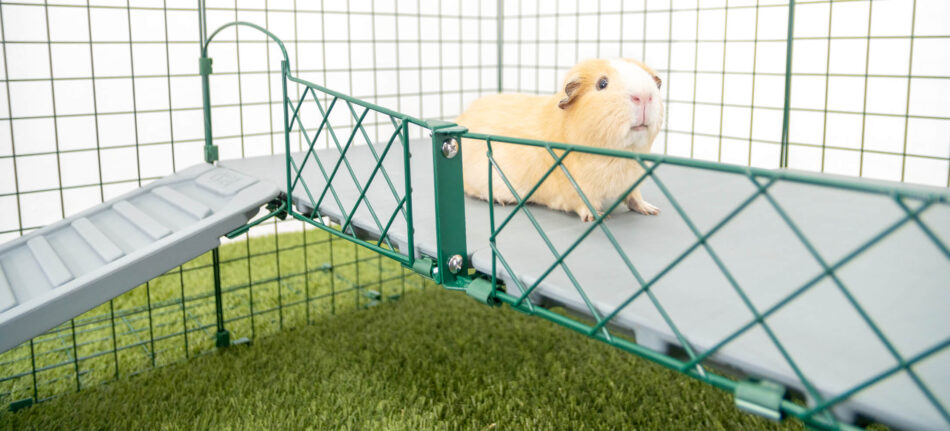
Guinea pigs, AKA Cavia porcellus originate from the South American Andes, where they lived amongst the varying terrains of the mountains. Foraging comes naturally to this species as their ancestors spent their days exploring the rocky landscapes and grasslands to find their next source of food. And whilst these pets are not built for marathons, what they do need is a combination of hutch and run along with extra tunnels and accessories to provide them with plenty of exercise space and mental stimulation. Omlet’s guinea pig products have been expertly designed to encourage this instinct, ensuring that today’s household cavies get the exercise they need.
How do guinea pigs exercise?
Whilst small mammals of the rodent families may all look adorable, fluffy and vaguely similar, hamsters and guinea pigs do not have the same needs. Therefore, hamster-style wheels and balls are not required (and can, in fact, be very dangerous for guinea pigs). Instead, you should make sure that the floor area of your guinea pigs’ hutch is a minimum of 0.75 square metres for hutches containing two cavies.
The floor area is where they’ll spend much of their time, so the bigger the living quarters, the better. The indoor part of a hutch is only half the story, though, and guinea pigs need some outdoor space, too. It is recommended that they should have at least three hours each day exploring, filled with plenty of exciting exercise, where they can run, skip, and popcorn! This is easy to arrange if you combine a hutch and run, and an all-in-one living space such as The Eglu Go Hutch for Guinea Pigs is the ideal option.
Guinea pig runs can also be linked to outdoor playpens using an arrangement such as the Zippi Guinea Pig Tunnel System. Whilst guinea pigs no longer have to search amongst the terrains of the Andes for food, this kind of flexible system allows you to construct anything from a simple A to B tunnel, to a full-blown maze with a delicious vegetable hunt, allowing them to practise this behaviour. Did you know that a guinea pig’s sense of smell is actually 25x better than humans?! Therefore, a tasty vegetable hunt using your Zippi Tunnel System, Zippi Shelter, and Guinea Pig Tunnels, is the perfect setup for physically and mentally stimulating your cavies!
For a pair of Guinea pigs, a one- to two-metre-square run provides ample space. If you can to give the pets more space than this, they will only really use it fully if it has plenty of tunnels and bolt holes to head for – guinea pigs don’t like to be too far away from somewhere safe and cosy, and will not usually roam in a large garden.
How do you exercise a guinea pig? – encouraging your cavy
Guinea pigs are more inclined to run around and have fun if they have companions to play with. So, rule number one for ensuring that your pets get enough exercise is to provide them with at least one playmate. In the wild, extended family groups could be at least10, but you should always keep the numbers to a level dictated by the size of the hutch and run. You need to get the mix right, as a male and a female will inevitably mate, which has obvious consequences in terms of space and mouths to feed.
Groups of males or groups of females are the best option. A castrated male will mix very happily and placidly with females, and any small disagreement and scuffles among your guinea pigs is unlikely to result in injury and is all part of their exercise routine.
Incorporating hiding places in your run/hutch/tunnel set up is an important detail. Guinea pigs instinctively have one eye on a safe bolt-hole when they are out and about, and scurrying back to safety is probably their most strenuous form of exercise.
You can encourage your pets to scout around and stretch their legs by putting interesting objects in their run, such as a Caddi Treat Holder, wicker toys stuffed with guinea pig treats, chews, tunnels and simple hideaways in the form of terracotta caves and igloos. They will also play happily with the cardboard tubes from the inside of loo-rolls and paper towels, or a simple cardboard box, especially if these items are stuffed with hay and fresh veggie treats.
One of the things that gives guinea pigs such a unique character is their loveable combination of endless inquisitiveness and nervousness. They follow their noses, explore everything, and then dash back to safety, making those wonderful wheep wheep sounds as they do so. With this mixture of playing and bolting, their exercise needs are easily met – all you need to do is provide the hardware.
Guinea pig exercise is all about exploring and interacting. They are very sociable animals, moving around their enclosure in groups or dashing away on little adventures of their own. You can find everything you need for your fluffy friends on the Omlet Guinea Pig shop and for even more ideas on guinea pig exercise why not take a read of our Guinea Pig Activities blog?
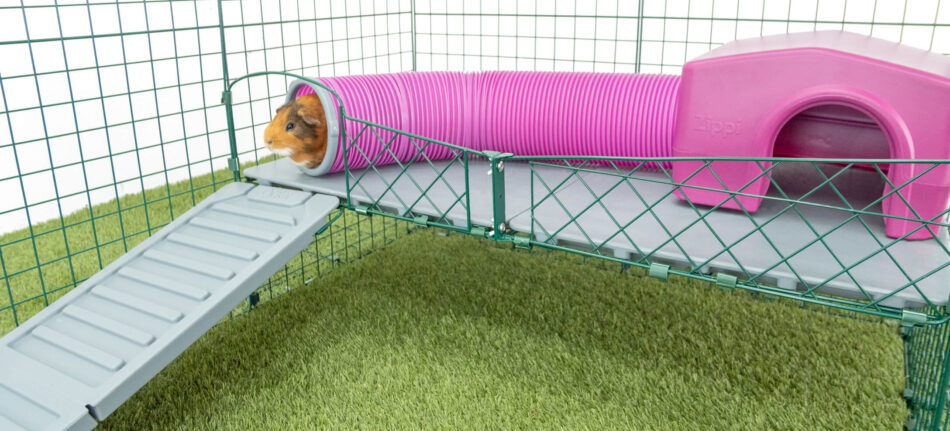
This entry was posted in Guinea Pigs on October 20th, 2020 by linnearask
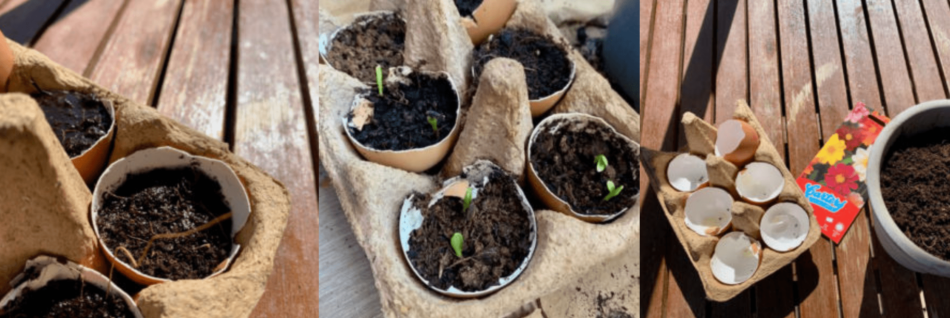
Next time you’re about to throw away your empty egg shells, spare the food waste bin and keep hold of them. Many people use crushed up egg shells in gardening to add calcium to the soil, however we have another great way you can use egg shells to add to your garden. Many propagators or seed starter tubs are made out of plastic, which isn’t great for the environment. Why not use your empty egg shells to start your next batch of seeds?! It’s so quick and easy to do!
1. Firstly rinse out the shells, and then let them dry.
2. Once dry, fill the egg shells halfway with compost and sit them in the egg carton.
3. Sprinkle a little water on the compost and then add your chosen seeds to the compost.
4. Spread a thin layer of compost on top and drizzle a little bit more water.
5. Then place in a sunny spot indoors – a window ledge is a great place to start seeds.
6. Keep watering your eggshell seeds each night, and after a few days you should start to see them sprout!
Once they’re too big for the shell then transfer to a bigger spot to continue growing indoors or outdoors depending on the chosen seeds (see packet for details).
This entry was posted in Crafting on October 19th, 2020 by linnearask

1. Don’t leave the coop and run in the sun
If possible, move the coop into a shaded spot, maybe under a tree or in the south-facing side of the backyard that doesn’t get as much sun. This means that it will be nice and cool when the girls want to go to bed in the evening, or if one of them wants to go in to lay during the day. The Eglu chicken coops are so easy to move that you, on a really hot day, could effortlessly move it around the backyard as the sun moves.
2. Don’t leave the water for too long
Your chickens will drink more in summer. To minimise the risk of algae in the water, as well as dust and dirt from the chickens, change the water at least once a day in hot weather. Place the drinker in a shaded spot on the run and make sure it’s really cold when you put it out.
3. Don’t overfeed your birds
Dried corn and grains take longer to digest than pellets or fresh food, which wastes energy and heats the body unnecessarily. The chickens will not need to eat as much in hot weather, and if they were to get hungry during the day, your backyard will be full of bugs and fresh green material at this time of year.
4. Don’t leave your chickens alone for too long
When it’s really hot outside it’s important that chicken owners keep an eye on their flock to look for signs of overheating. An open beak, panting and wings held away from the body are signs the chicken is hot. If you think one of your hens is really struggling, try dipping her bottom in a bucket of cold water. This will cool her down for a bit and allow the body to reset.
5. Don’t depend on water
You can leave a small paddling pool or shallow containers out for your chickens to cool down in, but it’s unfortunately not very likely your hens will use them. It might be better to create a mud bath in a corner of the run; chickens are much more likely to approach mud and sand to cool down than water.
6. Don’t play with your chickens
Interaction with the chickens might lead to more movement for them, which increases their body temperature. If you want to spend time with your pets, or need to pick them up for health checks, do so early in the morning or late at night when it’s cooler.
7. Don’t cover the run completely
Covering your chicken run with a lot of covers might seem like a good idea to create a shady spot, but if you don’t let air circulate, it’s likely to become a boiling tunnel of warm air. It’s extremely important to have ventilation, so that fresh air can move around. This goes for your coop as well. The Eglu’s cleverly designed ventilation system allows air to circulate in the coop at all times, keeping it nice, cool and fresh even on the hottest of days. Choose a few darker covers to give your pets shade on the run as well.
8. Don’t leave the eggs
You’re probably getting fewer eggs than normal during the warmest weeks of the year. That’s completely normal, chickens don’t lay as much when they are hot, and some go broody and stop laying completely. Although the eggs won’t go off if you leave them in the nest box of an Eglu for a day, eggs in the nest can encourage broodiness and result in egg eating, so it’s good to collect all as soon as you discover them.
9. Don’t put off cleaning
It’s always important to keep the coop nice and clean for your girls, but maybe even more so in summer. Parasites and pests are stronger when it’s warmer, including red mite, so make sure to use a bird safe disinfectant and cover roosting bars and perches in mite powder to prevent problems at least once a week.
10. Don’t treat all chickens the same
If you have a flock with mixed breeds or have had chickens in the past but now own a different breed, remember that different chickens need different care. Some breeds are much better than others at handling heat, and some really struggle. Read up on the breeds you’ve got here, and take extra care of vulnerable birds.
This entry was posted in Chickens on October 16th, 2020 by linnearask
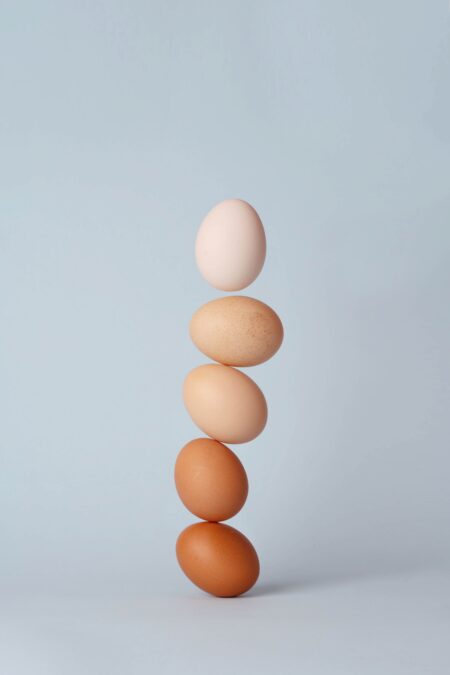 Most people would agree that the yolk is the best part of the egg. A double-yolker in the breakfast pan is therefore a very welcome sight!
Most people would agree that the yolk is the best part of the egg. A double-yolker in the breakfast pan is therefore a very welcome sight!
Some hens lay double-yolkers every time, a genetic quirk that simply means two yolks are released into the system instead of one. However, hens that manage this impressive feat are rare, and no single breed has been developed to pull off the double-yolk trick every time.
The one-egg-with-two-yolks breakfast can still be yours every day, though, if you’re willing to pay extra for it. You may have spotted double-yolk ‘super eggs’ on the shelves of certain supermarkets – sold at a premium, of course – but these are nearly all from young birds, rather than the mythical Double Yolker breed. It’s worth pointing this out, as a Google search will lead to some interesting information about such a breed. But it doesn’t exist – yet!
Most double-yolk eggs encountered by chicken keepers come from young hens. Point-of-lay birds tend to produce a very small egg or two, and then a couple of double-yolkers, before their bodies settle down into a regular four or five eggs-per-week pattern. A double-yolk egg after this early laying stage is very rare in most birds, although some hens begin to produce double-yolkers again towards the end of their egg-laying lives. Circumstantial evidence suggests that the Rhode Island Red, Oxford Brown, Sussex, and Leghorn breeds have a higher chance of producing double-yolkers.
How Are Double Yolks Formed?
Hens’ bodies release a yolk approximately two hours after the previous egg has been laid. Once in the hen’s oviduct – the part of the bird’s body in which the eggs are formed – the yolk is surrounded by the white albumen part of the egg and then covered in hard calcium. If a hen has released two yolks side-by-side, the egg-forming process treats them in the same way as a single yolk, resulting in two yolks ‘trapped’ inside a single egg shell.
If double-yolked eggs are fertilised, the result is two chicken embryos in one shell. Most of these ‘twin’ eggs fail to develop properly, though, with only one chick growing beyond the early development stage, or with neither of them developing. This makes it rare for two chicks to emerge from one egg. Chicken breeders are advised to put aside the double-yolkers to prevent them developing, and in commercial operations most double-yolkers are sold to food companies that use eggs in their products.
How Can You Tell If An Egg Has Two Yolks?
You don’t need to crack the shell to find out what’s inside – you can spot a double-yolker by ‘candling’ the egg. The word candling comes from the ancient practice of holding an egg in front of a candle flame, but a small torch does the job just as well (although they are still ‘candled’ rather than ‘torched’!) If there are two yolks inside, they will be visible as two dark blobs against the bright light as it shines through the shell.
So, although double-yolkers are estimated to occur in just one per thousand eggs, the sheer abundance of point-of-lay hens means that they are a common sight on the plates of chicken keepers around the world.
Triple yolkers, however, are very unlikely to grace the breakfast table. This super-rarity is found in just one egg per 25 million!
This entry was posted in Chickens on October 13th, 2020 by linnearask
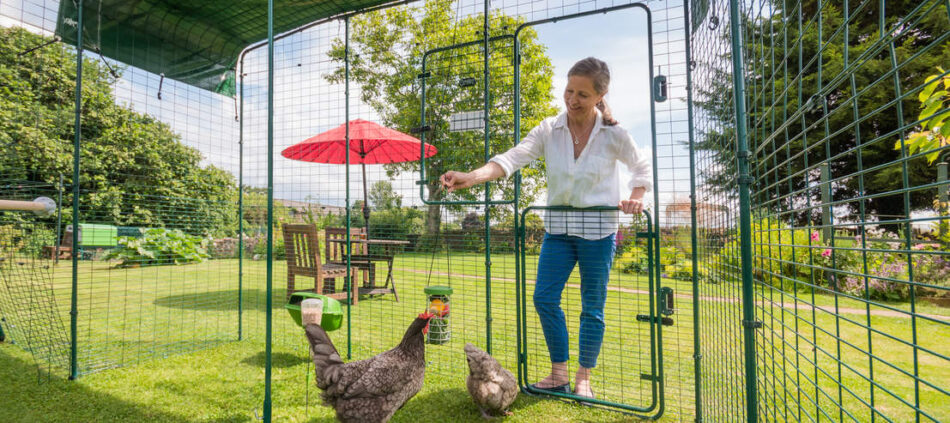
1. You have created a social media page for your Hens
Let’s face it, when you invest in a chicken coop and purchase your first flock you have to share it with friends and family. Whether it is documenting first eggs laid in the coop to your gourmet recipes with your farm-fresh eggs you are posting it on Instagram, Facebook, or Twitter.
2. You find eggs throughout the house
As you start becoming more comfortable with your chickens maybe you decide to let them into your home. They never bother anybody and get along great with your other pets but occasionally you find a fresh egg in your fruit bowl or on top of your favourite armchair. Hey, at least you know they are comfortable!
3. A “staycation” is your idea of a holiday
When you invest in your first brood you feel like you are a second parent to these animals. You wash them, feed them, and make sure they are comfortable. Add that in with taking care of your own kids and the idea of going on holiday is the last thing on your mind. You would much rather set up a zoom background of the beach or the tropics, order in a favourite meal, and put your feet up. Ahhh!
4. You find yourself chatting with your chickens
Sometimes we just need a good therapy session with an attentive listener, and who better than your chickens. They will never talk back to you or judge you for your decisions. They may give the occasional nudge or peck for a pet but hey, it is cheaper than therapy.
5. You have pet names for your hens
After the first couple weeks of tending to your chickens you start noticing some have different personalities. Some are on the shy side, some are very particular about their feeding time, and some just want all of the cuddles in the world. What a perfect time to give them a name! Whether it is Rudy, Cleo, or Fluffy we don’t judge here because they are your pets.
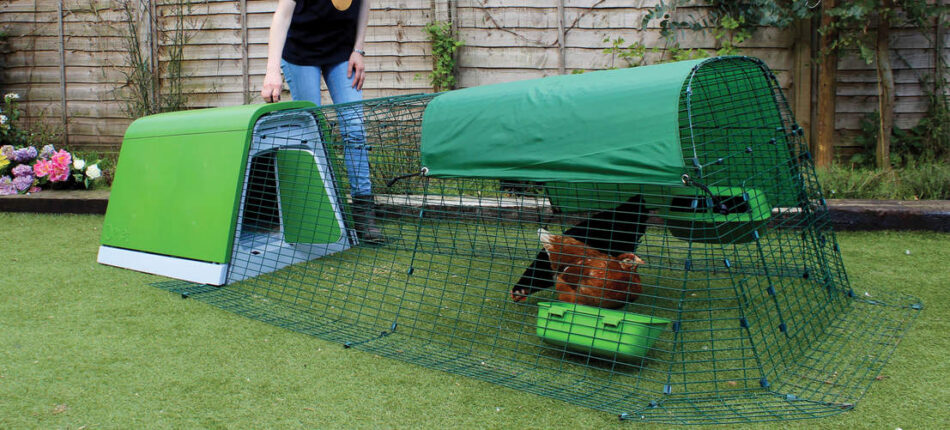
6. The home is filled with fashionable fowl décor
Whether it is chicken cocktail napkins or a hen-tastic serving platter you or your friends have made sure that you have all of the latest in chicken-related home furnishings.
7. You have a carrier bag to transport your chickens
Maybe you need to take them to the vet like any of your other pets. Who says that they shouldn’t be comfortable? That is why you have the top of the line carrier to transport your chickens whenever they are unwell.
8. Dressing up your brood for special occasions
When you have spring chickens or fall fowls they must be dressed for the season. When Halloween comes around you wouldn’t put it past yourself to dress up your chickens in a matching outfit with your other pets.
9. Instead of walking the dog you find yourself walking the flock
Yes, there are harnesses for chickens because you have already researched it on Amazon. Maybe you have limited land and your chickens need to stretch their legs each day, so you take them to the local park to graze and get some fresh air. Totally normal, right?!
10. You find yourself building a chicken picnic table for feeding time
We have all seen the trend of building mini picnic tables for our squirrel friends in our backyard. If you haven’t just Google it and you will be entertained by these structures. Well, who says your chickens should have any less than the squirrels. You paint your own table to pour your chicken feed into each day so your chickens can chow down in style.
At the end of the day, we understand that when you decide to venture out into the land of chicken coops it can be a daunting process. Everyone has unique experiences and should be able to tend to their hens/ roosters in their own way. Your flock is part of your family so why skimp on their care and upkeep!
This entry was posted in Chickens on October 7th, 2020 by linnearask
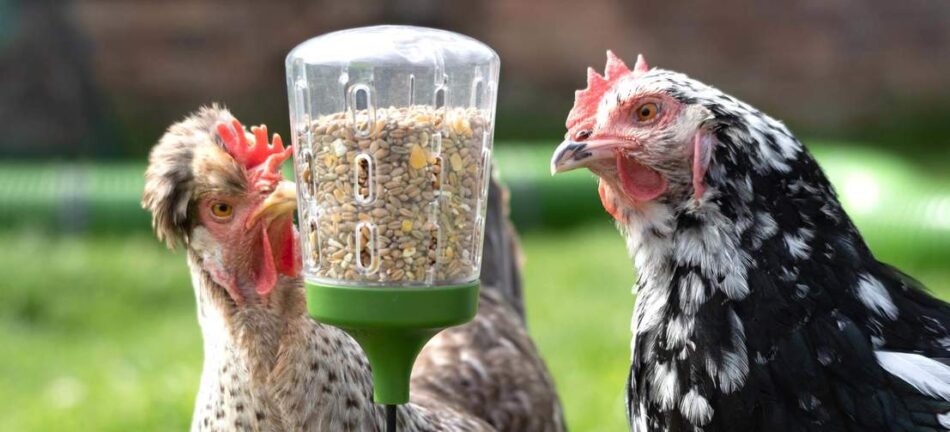
The very short answer to that question is probably no. If you give your chickens a good quality feed and some corn, and let them peck around the garden for insects and small stones they use to grind down their food they should technically be getting everything they need.
Any supplement should be given to your chickens as a complement to a healthy and balanced diet, and not instead of giving them good feed or sufficient space to live out natural chicken behaviours. However, just like you might boost your own system with some extra vitamins and minerals, there are some things that you can give your hens that will help them stay healthier and give them more energy.
Particularly useful at more challenging times, like around a moult or during a particularly tough cold snap, we’ve listed all the supplements you might want to have in your cupboard:
Grit
Chickens don’t have teeth, but use small rocks and stones to grind their food down. Most free range chickens gather grit naturally while exploring the garden, but if you for some reason have to contain your chickens to a smaller area than normal, or if their run is covered in snow, you might need to add grit to their diet.
Make sure to choose something that is chicken specific and will have the right composition and size of components.
Vinegar
Vinegar, normally Apple Cider Vinegar, is a great booster all year around. It aids digestion, keeps internal parasites at bay, and is mildly antiseptic. In the winter it’s also fantastic to use preventatively to keep respiratory infections away from your flock.
Choose an organic or unpasteurised vinegar that contains a substance called ‘the mother’. It’s a gel-like substance that grows naturally on the vinegar, and it’s the mother that contains the most powerful enzymes and minerals that make the vinegar so beneficial.
Vinegar can be added to the chickens’ drinking water, approximately 10ml per litre of water.
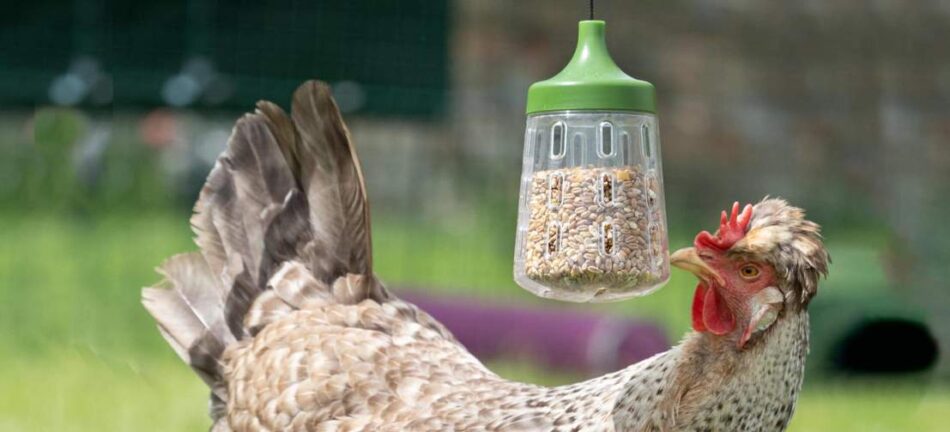
Garlic
As well as keeping vampires away, garlic has been used for its beneficial properties for centuries, and it’s a great addition to your chickens’ diet.
You can crush up a fresh clove or use garlic powder to add to the feed. It’s great for circulation, and can help with respiratory infections. It’s also said to help ensure a good appetite, so it’s ideal to give it to newly rescued hens that need a nutrient boost.
Herbs
Plenty of herbs and spices are said to have medicinal properties that will help your hens keep their immune system in top condition. Verm-X is a 100% natural supplement that helps maintain intestinal hygiene and keeps the hen’s gut and digestive system in great condition, which can help keep parasites and infections away.
Oregano, cinnamon, parsley, turmeric and ginger are other chicken favourites that will increase vitamin levels and aid the immune system, and that grinded down can be mixed into your chickens feed.
Calcium
Chickens use lots of calcium to build egg shells, so laying chickens can sometimes need a little more than they get from their pellets.
Choose a supplement that contains high levels of calcium and phosphorus and will strengthen the quality of your chickens’ eggs. This is especially important for ex battery hens or hens going through a moult.
This entry was posted in Chickens on October 7th, 2020 by linnearask
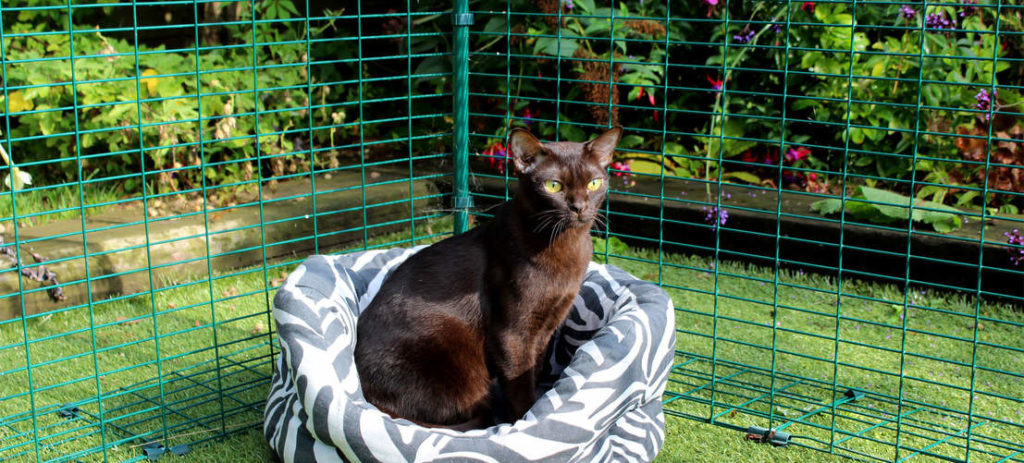
Cats that are let outside have a shorter life expectancy than indoor cats. Sure, some outdoor cats live until they’re 20 years old, but on average, letting your cat roam free outside significantly increases the risk of injuries, accidents, and infections.
There are clear pros and cons for both indoor and outdoor cat, but certain factories can encourage the decision to keep your beloved pets indoors most of the time.
Traffic
Cats and cars don’t mix, and if you live by a busy road you might not want to run the risk of letting your cat out to roam freely. Even the cleverest of cats can’t assess speed from a moving vehicle, and you’ll struggle to train them not to chase a mouse over the road without first checking the coast is clear.
Indoor breeds
Some cats are just not made to go outside. Their fur might not be thick enough to handle neither sun nor rain, they are not agile enough to move around different structures and textures, might not have the street smartness to stay out of trouble, or will just never see the point of outdoor activities, like exploring and hunting.
Cats with FIV
Feline Immunodeficiency Virus is a very contagious disease that significantly lowers your cat’s immune system. If your cat has been diagnosed with FIV, it’s highly recommended that you keep him or her indoors to stop them from passing the virus on, but also to protect them from infections or injuries that their immune system can’t handle.
Wildlife protection
Letting your cats roam free allows them to express natural behaviours, and one of these is the strong urge to hunt. While no one really cares about the odd mouse cats kill, people can get very upset when they see your cat bringing home song birds, baby hares or rare lizards. Wildlife fans are often great opponents of cat predation, and even if you trust your neighbours not to hurt your pet, letting your cat out might create an uncomfortable glitch between you and the rest of the neighbourhood.
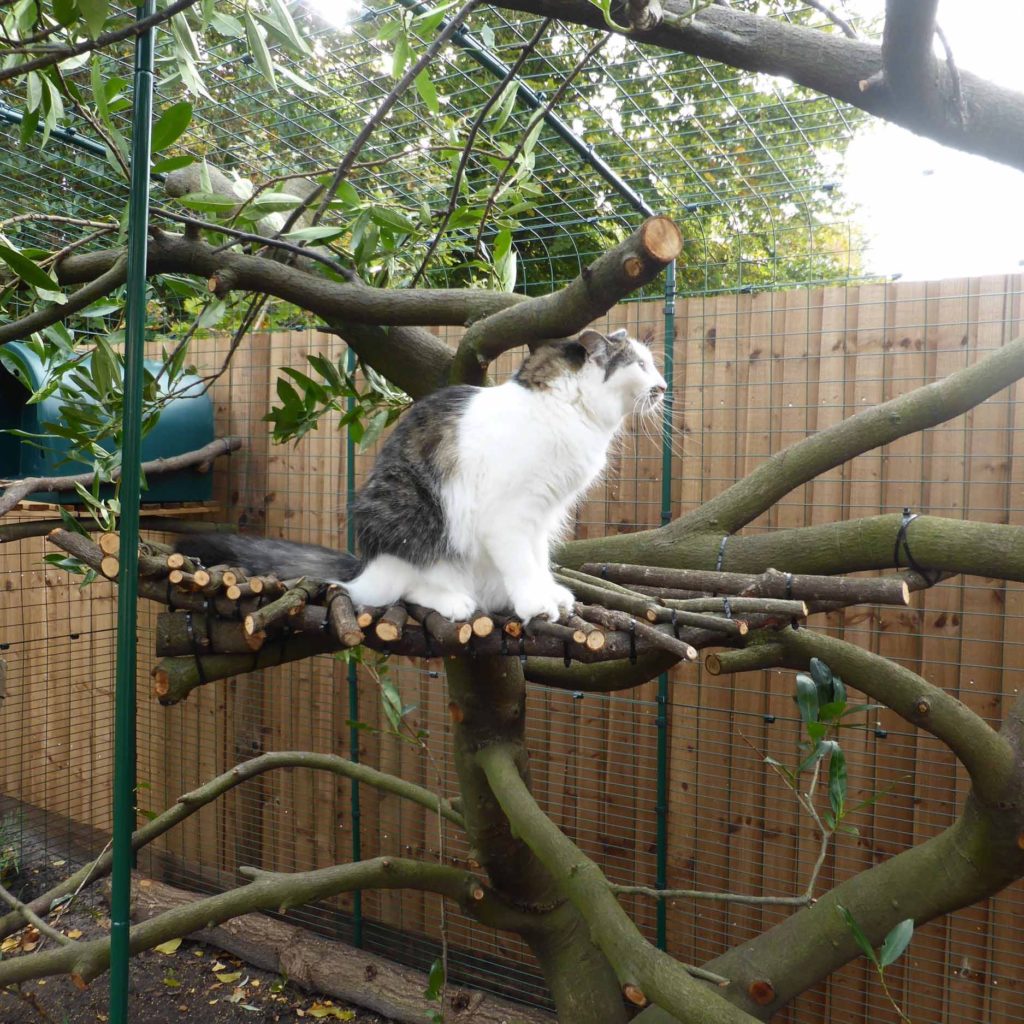 Cat thefts
Cat thefts
Cat thefts are more common than you might think, maybe not surprisingly seeing how much some popular cat breeds cost. Thieves might keep an eye on your cats comings and goings over a few days, and lure them away when no one will notice.
It’s important to be aware that this does happen, and if you have an expensive cat you might not want to let it run free outside without supervision.
Illness and injuries
If your cat is sick or has hurt themselves in some sort of accident, the vet might have told you to at least temporarily keep them indoors. While this can be extremely frustrating for both cat and owner, it’s important not to hurry the healing process by letting your cat out too early.
If any of these apply to you and your cat, or if you for some other reason have decided not to let your pets roam free, you’ll be glad to know that there is a great solution that will both give your pet access to fresh air (which is highly beneficial to both their physical and mental health) and keep them safe: a cat run.
The Omlet Outdoor Cat Run, or Balcony Cat Run, can be customised to fit the space you’ve got in your garden or on your balcony. It’s just over 2m high, so you can easily go inside to spend time with your cat in the run if you want, or you can leave them to play or rest in the sunshine while you tend to the garden.
The run can be placed on most surfaces, and you can decorate it with climbing toys and scratching posts to keep your cat active and entertained. It’s stable and secure, so you won’t have to worry about leaving your cat unsupervised for shorter periods of time.
Not having to walk your cat on a lead will mean he or she can be outside for longer, and by adding covers to your run you can make sure they won’t get rained on, or burn their skin in the sun.
In a cat run, your pet won’t get into contact with traffic or any other, potentially unfriendly cats. You will be able to limit and control how much he or she moves around to not over activate bones and muscles, and the risk of theft is greatly reduced. Not only will your cat be safer, small rodents and song birds can also live a slightly more relaxed life!
This entry was posted in Cats on October 7th, 2020 by linnearask




 How Can You Make Sure Each Hen is Getting Her Share of the Food?
How Can You Make Sure Each Hen is Getting Her Share of the Food?



 Most people would agree that the yolk is the best part of the egg. A double-yolker in the breakfast pan is therefore a very welcome sight!
Most people would agree that the yolk is the best part of the egg. A double-yolker in the breakfast pan is therefore a very welcome sight!




 Cat thefts
Cat thefts